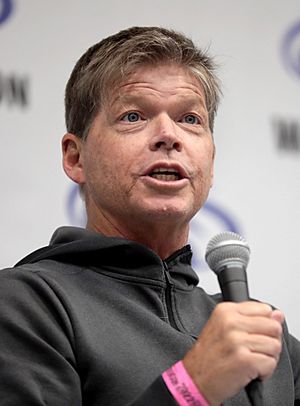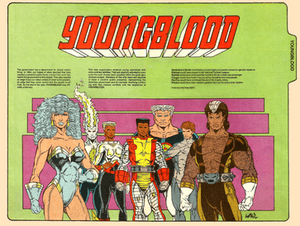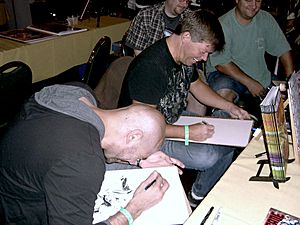Rob Liefeld facts for kids
Quick facts for kids Rob Liefeld |
|
|---|---|

Liefeld at the 2022 WonderCon
|
|
| Born | Robert Liefeld October 3, 1967 Fullerton, California, U.S. |
| Area(s) | Writer, Penciller, Inker, Editor, Publisher |
|
Notable works
|
|
| Awards | Inkpot Award (2012) |
Robert Liefeld (born October 3, 1967) is an American comic book artist and writer. He became very well known in the 1990s. He helped create popular characters like Cable (with writer Louise Simonson) and Deadpool (with writer Fabian Nicieza).
In the early 1990s, Liefeld became famous for his work on Marvel Comics' The New Mutants and then X-Force. In 1992, he and other popular Marvel artists started their own company, Image Comics. This was a big deal because it meant creators could own their characters, not just the publishers. The first comic from Image Comics was Liefeld's Youngblood #1.
Contents
About Rob Liefeld
Rob Liefeld was born on October 3, 1967, in Fullerton, California. He grew up in Anaheim, California. His father was a minister and his mother was a part-time secretary.
Early Love for Comics
Liefeld loved comics from a young age. He decided early on that he wanted to be a professional artist. He started by tracing artwork from comic books. In high school, he took art classes.
He also went to comic book conventions at the Disneyland Hotel. There, he met famous creators like George Pérez and John Romita Jr.. Liefeld says that Pérez, along with John Byrne and Frank Miller, were big influences on his art.
Rob Liefeld's Career
Starting Out in Comics
After high school, Liefeld took drawing classes. He worked odd jobs like delivering pizza while practicing his art. He sent his drawings to smaller comic publishers first. He was too nervous to send them to big companies like Marvel Comics and DC Comics.
Around 1985, he sent samples to Gary Carlson of Megaton Comics. Carlson liked Liefeld's clear storytelling. He also saw the influence of artist George Pérez in his style. Carlson used one of Liefeld's drawings in Megaton #5. He also featured Liefeld's own superhero team, Youngblood, in Megaton Explosion #1 (June 1987). This was the first time Youngblood appeared in print.
Success with DC and Marvel Comics
Liefeld went to a comic convention in San Francisco. He showed his drawings to editors there. An editor from Marvel Comics, Mark Gruenwald, offered Liefeld a job. He was asked to draw an Avengers story.
His first published story was in Warlord #131 (September 1988) for DC Comics. Next, he drew the five-issue miniseries Hawk and Dove for DC Comics. This work made him known to many comic readers.
Soon after, Liefeld started working for Marvel Comics. His first Marvel job was The Amazing Spider-Man Annual #23. In 1989, Liefeld became the main artist for Marvel's The New Mutants. He is often given credit for making this comic very popular.
With The New Mutants #98, Liefeld took charge of the series. He drew, inked, and planned the stories. Fabian Nicieza wrote the dialogue. The New Mutants ended with issue #100. It was replaced by a new team called X-Force. The first issue of X-Force in 1991 sold four million copies. This set a record for the comic industry.
Starting Image Comics
Liefeld's relationship with Marvel changed in 1991. He announced plans to publish a new comic with another company. In 1992, Liefeld and several other popular artists left Marvel. They included Jim Lee, Todd McFarlane, and Erik Larsen. They formed Image Comics.
Each co-founder started their own studio under Image. Liefeld's studio was called Extreme Studios. His superhero team series Youngblood was the first comic Image published.
Other comics from Liefeld's Extreme Studios in the 1990s included Brigade, Bloodstrike, Glory, Prophet, Supreme, and Avengelyne.
In 1996, Liefeld's studio worked with Marvel again. This project was called "Heroes Reborn". Liefeld was supposed to write The Avengers and draw Captain America. However, Marvel ended the agreement after six issues.
Leaving Image Comics
In June 1996, another Image co-founder, Marc Silvestri, temporarily left Image. This was due to disagreements with Liefeld. In September, Liefeld announced he was leaving Image Comics. The other Image partners also announced they had fired him. Liefeld then started a new company called Awesome Comics.
Awesome Comics and Beyond
At Awesome Comics, Liefeld tried to buy the rights to Fighting American. This character was similar to Captain America. Liefeld also hired famous comic writer Alan Moore. Moore wrote for Youngblood, Glory, and Supreme. Moore won an award for his work on Supreme. Awesome Comics stopped operating in 2000.
In the 2000s, Liefeld returned to his Marvel characters. He drew for Cable and X-Force. In 2004, he worked with Fabian Nicieza again on an X-Force miniseries. He also drew early covers for Nicieza's Cable & Deadpool.
In 2007, Liefeld and writer Robert Kirkman worked on a new Killraven series. Five issues were finished, but they were never printed. In July 2007, it was announced that Rob Liefeld and Youngblood would return to Image Comics. This new Youngblood series started in January 2008.
Recent Work
In 2010, Liefeld returned to the Deadpool character. He drew for the Prelude to Deadpool Corps series. He also became the regular artist for Deadpool Corps.
In 2011, Liefeld was announced as the artist for The Infinite. This was a mini-series written by Robert Kirkman. In 2011, he also became the artist for a new Hawk and Dove series for DC Comics. This was part of The New 52 relaunch. When that comic ended, Liefeld took over three other titles: Grifter, Deathstroke, and The Savage Hawkman. He wrote and drew Deathstroke. He left DC Comics in August 2012.
Liefeld returned to his own characters in 2011–2012. New comics were made by other writers and artists. These included Avengelyne, Bloodstrike, Glory, and Prophet. He also published new versions of Youngblood and Supreme in 2012.
Liefeld made a small appearance in the 2016 Deadpool movie. In 2017, it was reported that Liefeld was working on a movie deal for his Extreme Universe characters.
In July 2020, IDW Publishing released Snake Eyes: Deadgame. This was a G.I. Joe comic series co-written and drawn by Liefeld. Around that time, Liefeld started a podcast called Robservations. He talks about the comics industry on it.
In October 2023, Liefeld showed a trailer for Bloodstrike. This was based on his Image Comics series from 1993. Bloodstrike is about a team of assassins who are brought back to life by a secret government program. Liefeld released the trailer to get new interest in making a Bloodstrike movie.
In February 2024, Liefeld announced he was retiring from writing or drawing Deadpool. He said he wanted to stop while his work was still strong. In October 2024, Liefeld announced a new Youngblood series. It was released through Image Comics in 2025. This was his first time working on that team in seven years.
In February 2025, Liefeld said he had ended his relationship with Marvel. He felt he was not treated well at the premiere of Deadpool & Wolverine. He also mentioned a disagreement about credits for the character Wolverine.
In March 2025, Liefeld said he would sell his new Youngblood series directly to readers. He used the Whatnot livestreaming platform. He explained that comic shops were not ordering his books well. He felt that selling directly to fans would be better. Liefeld had sold directly to fans before. In 2013, he ran a Kickstarter campaign for his Brigade series.
|
See also
 In Spanish: Rob Liefeld para niños
In Spanish: Rob Liefeld para niños




